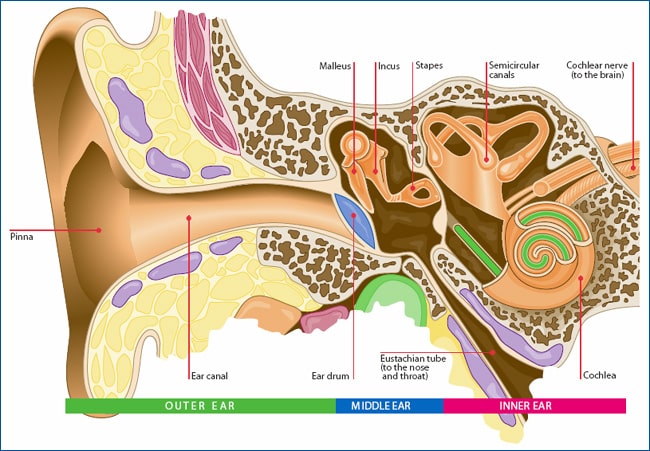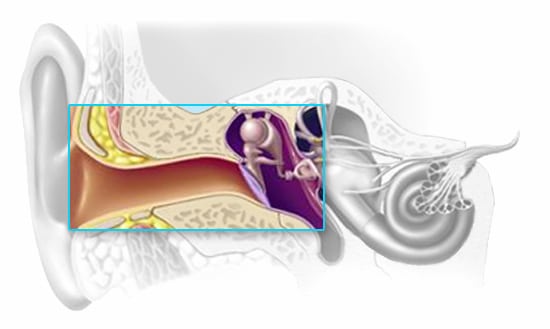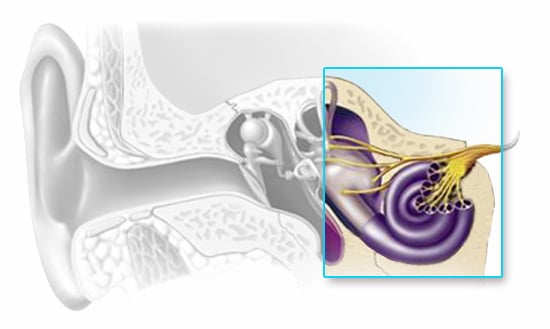Hearing loss is typically described as either congenital or acquired. As the names suggest, the congenital variety is present from birth (or soon after), while the latter is acquired at a later point in life and can be due to a number of factors. The hearing system is a complex one and as such, there are a number of parts involved that can be affected. Types of hearing loss and their causes are varied, but there are certain categories that they will fall into. These are referred to as conductive hearing loss, sensorineural hearing loss, and mixed hearing loss (a combination of both conductive and sensorineural).
Congenital Conditions
There are a number of congenital conditions that can cause hearing loss from birth. These can be divided into two distinct categories: non-genetic and genetic.
Non-Genetic Hearing Loss
Non-genetic factors are responsible for around a quarter of congenital hearing loss cases, with some being avoidable and others not. These include:
- Prematurity
- Maternal infections (e.g. Rubella, cytomegalovirus)
- Injuries sustained at birth
- Low birth weight
- Maternal diabetes
- Lack of oxygen
- The effects of toxins (drugs and alcohol consumed during pregnancy)
- Blood poising and toxaemia
Genetic Hearing Loss
Genetic factors or hereditary conditions are believed to be responsible for more than half of all cases of hearing loss. Described as autosomal dominant or autosomal recessive, genetic hearing loss can be present at birth or develop later in life. With autosomal recessive hearing loss, both mother and father carry the recessive gene which is passed on to the offspring. This type of inheritance pattern is responsible for the vast majority of genetic hearing loss (about 70%), while the autosomal dominant genetic pattern is only responsible for approximately 15%. There are also other some much rarer types of genetic hearing loss that are related to the sex chromosome (X-linked) and mitochondrial inheritance patterns.
When it comes to genetic syndromes, hearing loss is usually one of many symptoms of the disease the individual is suffering from. Hearing loss can occur as a result of:
- Pendred Syndrome
- Alport syndrome
- Down syndrome
- Waardenburg syndrome
- Otosclerosis
- Crouzon syndrome
- Usher syndrome
- Treacher Collins syndrome
Conductive Hearing Loss
In contrast to congenital conditions, conductive hearing loss is caused by some type of blockage or damage in the outer ear or middle ear – or in some cases both. Ear infections, perforated eardrums or blockage caused by a build up of earwax can result in a loss of loudness that typically characterises conductive hearing loss. Other causes include:
- Inadequate Eustachian tube function
- Allergies
- An abnormal formation of the outer ear, ear canal or middle ear structures
- Fluid in the middle ear (usually as the result of a cold)
- Benign tumours
- Ear canal infection
- Foreign bodies in the ear
- Otosclerosis
Conductive Hearing Loss Treatments
Individuals suffering from conductive hearing loss will not go completely deaf, and these types of conditions can often be treated medically or corrected with an operation depending on the cause of their hearing impairment. Infections are most commonly treated with antibiotic or antifungal medications, while malformation or dysfunction of the middle ear structure is usually surgically corrected. In cases where surgical correction has not helped, a conventional hearing aid or bone conduction hearing aid may be of benefit.
Sensorineural Hearing Loss
Sensorineural hearing loss is caused by a malfunction of or damage to the cochlea or the hearing nerve. Hearing loss symptoms include a loss of loudness and clarity, with causes including diseases, viruses, ageing, and repeated exposure to excessive noise. Some of the diseases and viruses that can lead to sensorineural hearing loss include:
- Labyrinthitis
- Meningitis
- Meniere’s disease
- Mumps
- German measles (Rubella)
- West Nile Virus (hearing loss associated with this is rare)
- Varicella Zoster Virus
- Presbycusis (the cumulative effect of ageing on hearing)
Sensorineural Hearing Loss Treatments
Sensorineural hearing loss symptoms are seldom able to be treated medically and are almost always permanent, so the solution to this type of hearing impairment is usually a hearing device. However, it is important to note that sensorineural hearing loss brought on by repeated exposure to excessive noise can easily be avoided by using hearing protection. Ear plugs are an affordable way to reduce decibel levels at events where loud music is going to occur, and if you regularly operate equipment such as chainsaws and jackhammers, it’s recommended that you wear earmuffs that are designed to protect the wearer from excessive and continuous noise.
Types of Hearing Aids Designed to Help Sensorineural Hearing Loss Sufferers
Invisible-in-Canal
Invisible-in-canal (IIC) devices are placed inside the ear and fit in the second bend of the ear canal, making them completely invisible – ideal for those who wish to conceal their hearing aids.
Completely-in-Canal
Completely-in-canal (CIC) hearing aids are amongst the smallest types of hearing aid available and are worn deep inside the ear canal, making them almost invisible to others.
In-the-Ear
Easy to insert and operate, in-the-ear devices are a great choice for the elderly or those who may have trouble with some of the smaller devices like IIC and CIC hearing aids.
In-the-Canal
Custom moulded to fit each individual ear, in-the-canal (ITC) style hearing aids are partially inserted into the ear canal, but not as deep as the CIC or IIC type of hearing aids.
Behind-the-Ear
Available in open and closed varieties, behind-the-ear (BTE) style devices are capable of excellent amplification and are particularly useful for those who suffer serious sensorineural hearing loss.
Receiver-in-the-Canal
Receiver-in-the-canal (RIC) devices work with the help of a tiny receiver that sits inside the ear canal. These hearing aids are known for their excellent sound quality and comfort.
Sudden Hearing Loss
Involving one or both ears, sudden hearing loss is diagnosed in individuals who experience a hearing reduction of greater than 30db (decibels) over three or more contiguous frequencies in a period of no longer than 72 hours. Hearing loss symptoms can span the length of a few days, while in some cases the hearing impairment may occur immediately. The profoundness of the hearing loss can vary widely from patient to patient, though males and females are equally affected. Tinnitus (a persistent ringing in ears usually caused by long term or sudden exposure to loud noise) is often reported by individuals with sudden hearing loss, with the disorder making up about 1% percent of all sensorineural hearing loss cases.
Sudden Hearing Loss Causes
Causes for this form of hearing impairment include:
- Infections
- Circulatory Issues
- Meningitis
- Benign tumours
- Metastatic carcinoma
- Bacterial labyrinthitis
- Meniere’s disease
- Multiple sclerosis
- Encephalitis
- Syphilis
- Autoimmune diseases
- Leukaemia
- Exposure to ototoxic medications
The cause of sudden hearing loss remains a mystery in the majority of patients. When the hearing impairment cannot be attributed to a specific known cause, it is recorded as idiopathic (meaning no known cause). Patients can find this diagnosis frustrating or upsetting, as they’re unable to be provided with an explanation for the hearing loss they’re experiencing.
A diagnosis of sudden hearing loss is the end result of a thorough physical examination that looks for infectious causes such as systemic diseases and takes into account whether or not the patient has been exposed to known ototoxic medications. A hearing test will be done in order to provide an audiogram which can determine the severity of the hearing loss. Blood studies are also usually performed in order to try and rule out or confirm systemic causes. These systemic causes can include syphilis, Lyme disease, and autoimmune, metabolic and circulatory disorders. An MRI (magnetic resonance imaging) brain scan is often performed to rule out the presence of a benign tumour (acoustic neuroma), which can exist in up to 15% of individuals suffering from sudden hearing loss.
Treatments for Sudden Hearing Loss
There are ways to combat sudden hearing loss, but due to there often being no definite cause for it, the best course of treatment is a controversial subject amongst medical professionals. However, treatments over the years have included antiviral medications, vasodilators, systemic steroids, and carbogen therapy. In some cases, due to the high number of spontaneous recoveries having been recorded, no treatment is recommended at all.
Mixed Hearing Loss
As the name suggests, mixed hearing loss is a combination of both conductive and sensorineural hearing loss. Individuals who suffer from this have some form of damage or deformity of both the outer or middle ear and the inner ear. The level of hearing impairment can range from mild to severe.
Mixed Hearing Loss Causes
Mixed hearing loss is the result of a combination of conductive damage in the outer or middle ear and sensorineural damage in the inner ear or hearing nerve. Causes can include:
- Genetic factors
- Diseases
- Birth defects
- Infections
- Benign tumours
- Head injuries
- Exposure to excessive noise
- Presbycusis (ageing)
Treatments for Mixed Hearing Loss
Mixed hearing loss can be treated with medication, different types of hearing aids, surgery, or an implantable bone conduction hearing system. The choice of treatment will depend on what conditions are responsible for the individual’s mixed hearing loss.
Arrange a Hearing Test Today
If you suspect you’re suffering from any of the above types of hearing loss, arrange a consultation with Victorian Hearing today. We can conduct a thorough hearing test to identify hearing loss and determine its severity. Call our audiologists now on (03) 9558 884 or contact us online.



